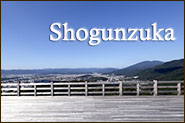Top °š Shogunzuka
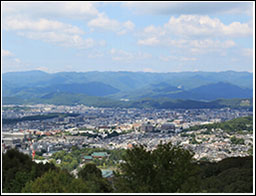
Shogun-zuka is a mound about 20 square meters in diameter. It is located north of Shijyo on Mt. Higashiyama.
When Emperor Kanmu was looking for a location to establish a new capital, he climbed to the area now known
as Shogun-zuka and decided to move the capital to Kyoto in 794. Emperor Kanmu buried the statue of a Shogun (-a
general) in the mound and prayed for the peace of the capital.
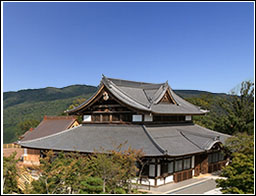
In 1913, Seiryu-den was built in front of Kyoto Kitano
Tenmangu Shrine as the Kyoto Branch of Japan Federation of Martial Arts°« training gym.
In 1947, the building was moved and became the martial
arts training gym for police officers named the °»Heian-dojo°…. Later, it was opened to the general public and many young people practiced martial arts there.
In 1998, the Kyoto Prefectural Office decided to close the
Heian-dojo, dismantling it and putting the pieces in storage.
Afterwards, Shoren-in recognizing the historic cultural
importance of the building decided to rebuild it at the top of Mt.Higashiyama as Seiryu-den.
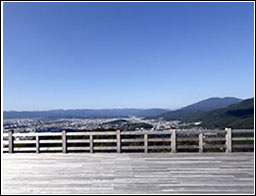
A vast wooden observation deck was constructed out from Seiryu-den.
The total floor area is 1046 m2 (-4.6 times wider than
the deck of Kiyomizu Temple). From this deck you can overlook
Kyoto city including landmarks such as Kyoto Imperial Palace,
Heian Shrine and Mt.Hiei. From the west observation platform you can see the buildings of Osaka as well as more of Kyoto city.
When Emperor Kanmu shifted the capital from Nara to Nagaoka to the south of Kyoto, several accidents occurred continuously. One day, Wake no Kiyomaro invited the Emperor to the mound atop the mountain. Looking down at the Kyoto basin, he suggested to the Emperor to shift his capital here because the land was very suitable for this purpose.The Emperor heeded his advice and began the construction of the capital, Heian Kyo, in 794 AD.
The Emperor constructed a clay statue of a general, 2.5 meters in height. He adorned the statue with armors, an iron bow and arrow, and swords before he buried it in the mound, as a guardian of the capital. Therefore, the place is known as Shogunzuka.
As depicted in literatures such as Genpei Josuki and Taiheiki, the legend states that the mound actually rumbles when the nation is in danger.
The place has also witnessed actual battles in the past.
In 1338, the rebel force of Nitta Yoshisada pitched a camp here and defeated the shogunate force of Ashikaga Takauji. In WW II, antiaircraft guns were positioned in this area.
Shogunzuka is indeed a remnant of several wars and warriors.
In the area, there are stone pillars and monuments, each with a pine tree hand planted by the political giants of the Meiji era, such as General Nogi, General Togo, middle General Kikuchi Takeo, and Okuma Shigenobu.
It is believed that each of those political giants stood at this very place and decided to build a wealthy nation, when looking down at the towns of Kyoto.
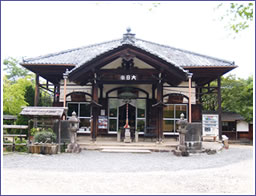
Located atop the mountain, near the mound, the temple is dedicated to a stone statue of the Taizokai Dainichi Nyorai. The statue was discovered in the ground, marked by a monument at present. Its appearance, eroded by rain and wind, symbolizes its history. For years, it has been worshipped as Dainichi-san (the word °»san°… is attached to names to show familiarity). Further, at the end of the Edo period, the imperial warriors used to pray to him for the safety of their lives.
The karesansui garden to the north of the temple was created by a gardener named Nakane Kinsaku.
As the weather becomes warmer, japonicas and Higan cherries begin to bloom, followed by cherries, peaches, wisterias, and azaleas. In autumn, magnificent red flowers beautifully color the entire area.
In winter, when the air becomes clearer, one can see far beyond the normal visibility.
Even today, the Shogunzuka mound is a good unknown spot; hence, not many people other than the locals and taxi drivers know about it.
Since you have discovered this site and are now aware about us, we invite you to please visit us.
We are certain that you will be impressed to see that a place like this exists in Kyoto.

There are two big observatories in the north and west parts of the precinct.
The west observatory is more than 10 meters tall, enabling you to actually look down at the city of Kyoto. You can also see beyond Mt. Kitayama to the north and Osaka to the south.
The north observatory is located at the northernmost corner in the precinct. From here, you can see the mountain peaks of Higashiyama, stretching from the Shogunzuka mound to Mt. Hieizan, which cannot be seen from the west observatory. The tall mountain that appears far beyond is Mt. Hieizan that has two peaks: Dai-Hiei, which is the bigger one and is on the left-hand side, and Sho-Hiei, which is the smaller of the two and is on the right-hand side. You can also see Mt. Daimonji, which has the character °»¬Á (dai, meaning big),°…under the Sho-Hiei.
Moreover, in front of the mound you can also find the Ginkaku-ji, Jodo-ji, and Honen-in temples. The green structure over the Kamo River is the Imperial Palace, Gosho.
Both the observatories provide great views of the entire city of Kyoto.


